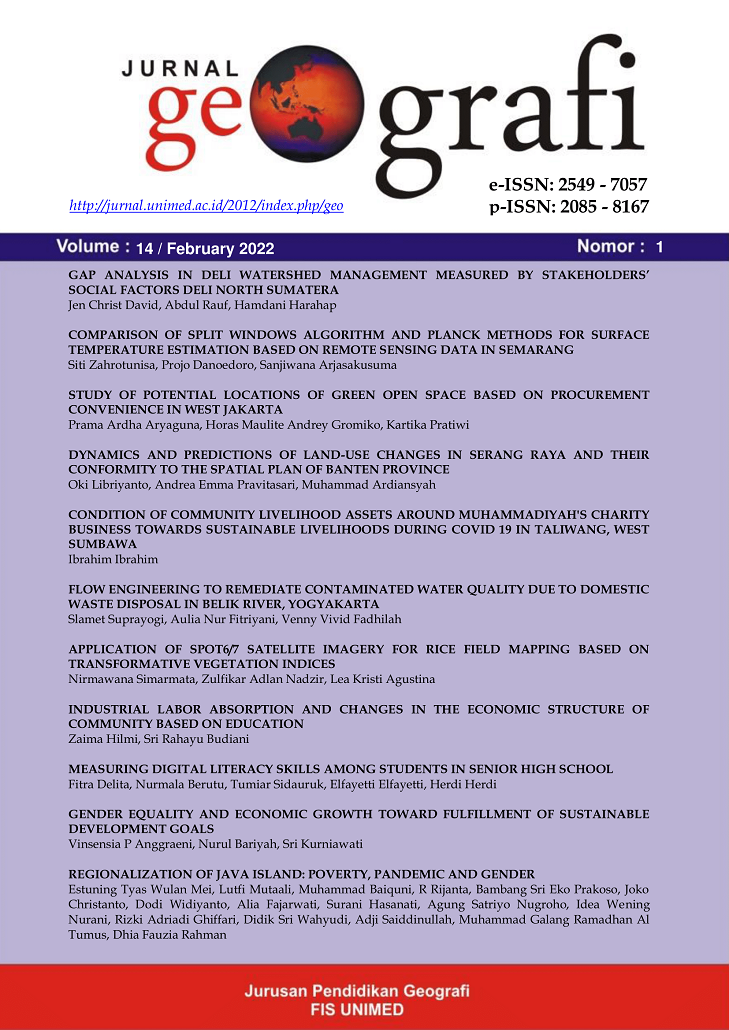INDUSTRIAL LABOR ABSORPTION AND CHANGES IN THE ECONOMIC STRUCTURE OF COMMUNITY BASED ON EDUCATION
DOI:
https://doi.org/10.24114/jg.v14i1.26921Abstract
Kendal Regency has developed into one of the Special Economic Zones. The development is to become one of the new industrial areas to improve the economy of the community and the region. This is undoubtedly related to the hope of increasing employment so that it is also able to increase employment and improve the economy of the community and the region. However, the availability of labor is still dominated by elementary school graduates/equivalent, and the impact of industrial development on the regional economy has not been seen significantly. Therefore, this study aims to determine the relationship between industrial growth and employment based on the last education completed, the relationship between industrial growth and industrial GRDP growth, and strategies that can be taken to maximize employment. This study uses secondary data collected from the BPS, namely Kendal Regency in Figures and Central Java Province, and related regional regulations. The primary data available is insufficient for data needs requiring time-series data. This study uses a quantitative method with the Kendalls'tau b correlation test and multiple correlation test analysis methods. It uses the calculation of the elasticity of labor and the projection of labor absorption. The result is that 1) there is a relationship between industrial growth and employment based on the last education completed, 2) there is no relationship between industrial growth and GRDP growth in the industrial sector, and 3) the strategy that can be done to maximize employment is to improve quality human resources and promote industrial growth.Keywords: employment, education, GRDP, industryReferences
Adiyaksa, Fitrian, and Prijono Nugroho Djojomartono. 2020. œEvaluasi Alih Fungsi Lahan Pertanian Menjadi Lahan Industri Di Kabupaten Kendal. Journal of Geospatial Information Science and Engineering 3(1):71“78. doi: https://doi.org/10.22146/jgise.55519.
Alfana, M. A. F. 2014. œStrategi Penghidupan Rumahtangga Miskin Perdesaan (Kasus Tiga Desa Kabupaten Kulon Progo Daerah Istimewa Yogyakarta). Universitas Gadjah Mada.
Apriyanto, D., and Rika Harini. 2012. œDampak Kegiatan Pertambangan Batubara Terhadap Kondisi Sosialekonomi Masyarakat Di Kelurahan Loa Ipuh Darat, Tenggarong, Kutai Kartanegara. Jurnal Bumi Indonesia 1(3):289“98.
Azhar, Kholidah, and Zainal Arifin. 2011. œFaktor-Faktor Yang Mempengaruhi Penyerapan Tenaga Kerja Industri Manufaktur Besar Dan Menengah Pada Tingkat Kabupaten/Kota Di Jawa Timur. Jurnal Ekonomi Pembangunan 9(1):91“106.
BPS. 2019. Kabupaten Kendal Dalam Angka 2019. Kendal: Badan Pusat Statistik Kabupaten Kendal.
Buchari, Imam. 2016. œPengaruh Upah Minimum Dan Tingkat Pendidikan Terhadap Penyerapan Tenaga Kerja Sektor Industri Manufaktur Di Pulau Sumatera Tahun 2012-2015. Jurnal EKSIS XII(1):73“85.
Cachelin, Adrienne, Jeff Rose, and Karen Paisley. 2015. "No TitleDisrupting Neoliberal Discourse in Critical Sustainability Education: A Qualitative Analysis of Intentional Language Framing." Environmental Education Research 21(8):1127“42. doi: 10.1080/13504622.2014.974023.
Chusna, A. 2013. œPengaruh Laju Pertumbuhan Sektor Industri, Investasi, Dan Upah Terhadap Penyerapan Tenaga Kerja Sektor Industri Di Provinsi Jawa Tengah Tahun 1980-2011. Universitas Negeri Semarang.
Forster, Andre G., Thijs Bol, and Herman G. van de Werfhorst. 2016. "Vocational Education and Employment Over The Life Cycle." Sociological Science 3:473“94.
Herawati, N., and H. Sasana. 2013. œAnalisis Pengaruh Pendidikan, Upah, Pengalaman Kerja, Jenis Kelamin, Dan Umur Terhadap Produktivitas Tenaga Kerja Industri Shutllecock Kota Tegal. Diponegoro Journal of Economics 2(4):1“8.
Hindun. 2019. œPendidikan, Pendapatan Nasional, Dan Penyerapan Tenaga Kerja Di Indonesia. Jurnal Pendidikan Ekonomi, Manajemen, Dan Keuangan 3(1):15“22.
Ilmiyah, Rosyikhotul, and Eko Darminto. 2020. œHubungan Antara Etika Berperilaku Dengan Kemampuan Berpikir Logis Dan Konformitas Pada Siswa Sekolah Menengah Pertama Di Sidoarjo. Jurnal Bikotetik 4(1):1“35.
Jung, Jin Hwa, and Dong-Geon Lim. 2020. "Industrial Robots, Employment Growth, and Labor Cost: A Simultaneous Equation Analysis." Elsevier: Technological Forecasting & Social Change 159:1“11.
Kurt, Resul. 2021. "Industry 4.0 in Terms of Industrial Relation and Its Impact on Labour Life." Procedia Computer Science 158:590“601.
Michael E., Porter, and Kramer Mark R. 2019. "Creating Shared Value. In: Lenssen G., Smith N. (Eds) Managing Sustainable Business." Springer, Dordrecht 323“46. doi: doi.org/10.1007/978-94-024-1144-7_16.
Nurkholis, Afid. 2018. "Teori Pembangunan Manusia: Human Capital Theory, Human Investment Theory, Sustainable Development Theory, People Centered Theory." INA-Rxiv 8trv7, Center for Open Science. doi: https://doi.org/10.31227/osf.io/8trv7.
Oktaviani, M. A., and H. B. Notobroto. 2014. œPerbandingan Tingkat Konsistensi Normalitas Distribusi Metode Kolmogorov-Smirnov, Saphiro-Wilk, Dan Skewness-Kurtosis. Jurnal Biometrika Dan Kependudukan 3(2):127“35.
Peters, Michael A. 2017. "Technological Unemployment: Educating for The Fourth Industrial Revolution." Educational Philosophy and Theory 49(1):1“6. doi: doi.org/10.1080/00131857.2016.1177412.
Purwasih, H., and Y. Soesatyo. 2017. œPengaruh Pertumbuhan Sektor Industri Terhadap Penyerapan Tenaga Kerja Di Kabupaten Sidoarjo. Jurnal Unesa Edisi Yudisium 5(1):1“6.
Santian, Putu Karismawan, and Baiq Saripta W. M. 2019. œFaktor Infrastruktur Dalam Pembangunan Ekonomi Kota Mataram. Ganec Swara 13(2):357“68. doi: https://doi.org/10.35327/gara.v13i2.103.
Sihombing, F. N. 2017. œKontribusi Tingkat Pendidikan Dan Upah Minimum Terhadap Penyerapan Tenaga Kerja Di Kota Medan Tahun 2012-2015. Jurnal Pembangunan Perkotaan 5(1):42“45.
Sulistiawati, R. 2012. œPengaruh Investasi Terhadap Pertumbuhan Ekonomi Dan Penyerapan Tenaga Kerja Serta Kesejahteraan Masyarakat Di Provinsi Di Indonesia. Jurnal Ekonomi Bisnis Dan Kewirausahaan 3(1):29“50.
Suprapto, H. 2016. œEvaluasi Kapasitas Produksi Dan Efisiensi Biaya Terhadap Kelancaran Proses Produksi Pada PT. Cahaya Indah Madya Pratama. Jurnal Penelitian Dan Ilmu Manajemen 1(1):58“66.
Suseno, Dhony Priyo, N. Soedarsono, and N. Anindyawati. 2017. œAnalisis Fampak Jalan Tol Terhadap Faktor Sosial, Ekonomi, Dan Lingkungan Di Desa Kaligangsa Kulon Kabupaten Brebes (Studi Kasus Area Pintu Tol Brebes Timur). Proceeding of SNST Ke-8 Fakultas Teknik Unwahas 1(1):7“11.
Trianto, A. 2017. œElastisitas Penyerapan Tenaga Kerja Di Provinsi Sulawesi Selatan. AKUISISI 13(1):15“38.
Wahyuningtyas, R., A. Rusgiyono, and Y. Wulandari. 2013. œAnalisis Sektor Unggulan Menggunakan Data PDRB (Studi Kasus BPS Kabupaten Kendal Tahun 2006-2010). Jurnal Gaussian 2(3):2019“2228.
Wibowo, W. A. 2013. œPengaruh Faktor Aglomerasi Industri, Angkatan Kerja, Dan Tingkat Upah Terhadap Pertumbuhan Ekonomi Kabupaten/Kota Di Jawa Tengah Tahun 2005-2010. Universitas Negeri Semarang.







